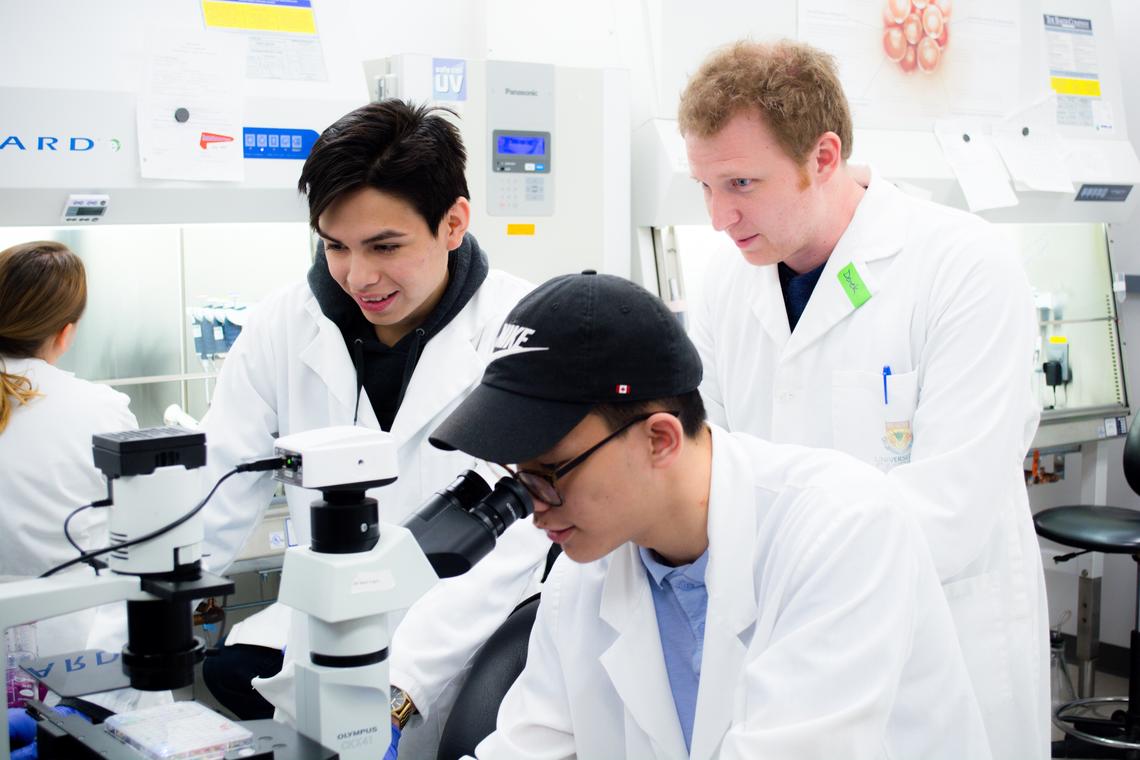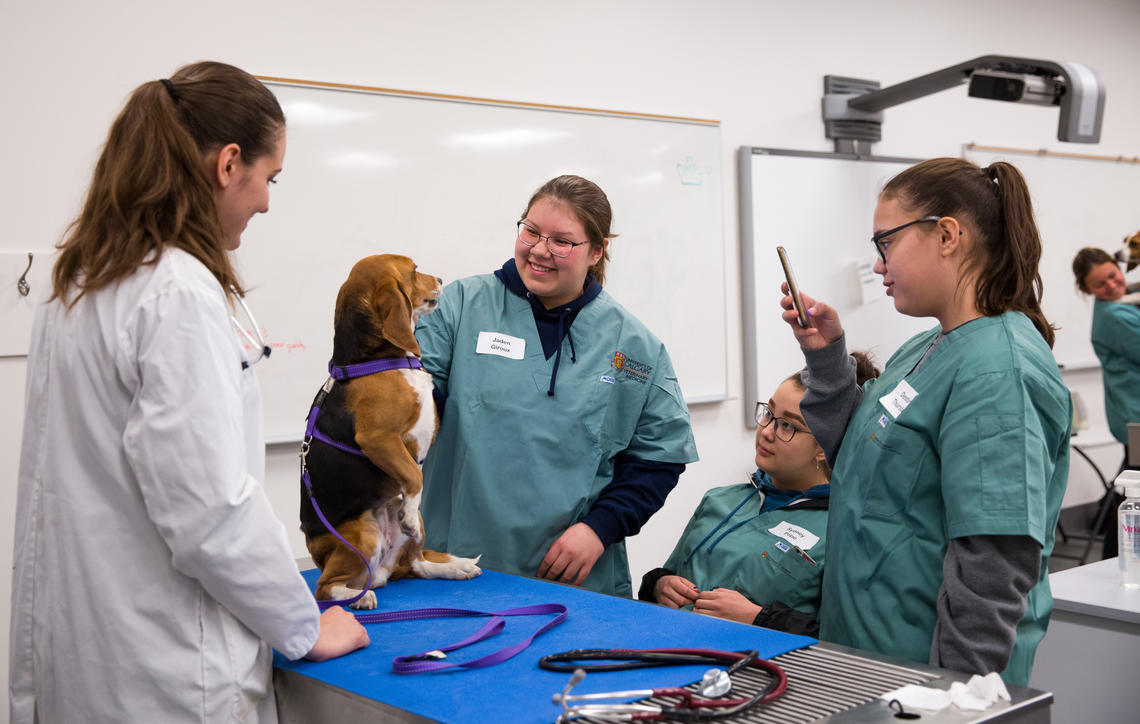May 22, 2018
UCalgary shares weird (and wonderful!) science of caring for animals

The gigantic plasticized cow stomach definitely made an impression. As did the towering model of a giraffe leg. There were also liquid-handling robots, centrifuge machines, biosafety cabinets — and even a mouse dissection.
- Above, Breanna Domak takes a shine to Skipper as she learns a bit about horse health from animal health tech Lisa Colangeli.
On Monday, it was all rather intimidating — scary even. By Friday, it was all familiar — and actually a lot of fun.
What a difference a week makes. That’s the takeaway from both high school students and University of Calgary Faculty of Veterinary Medicine (UCVM) mentors who recently took part in the Verna J. Kirkness Science and Engineering Education Program.
The scholarship program, now in its 10th year, connects First Nations, Métis and Inuit high school students with university scientists (and their high-tech labs) and gives them a week-long hands-on learning experience on university campuses. This year, 140 students and six Canadian universities are participating. The goal is to encourage students to study science and engineering in university.
This is the first year the program was held at the University of Calgary — and its first time in Alberta.
The program was founded by Powell River, B.C. couple Ron Woznow and Susan O’Brien and is named after Kirkness, an associate professor emerita at the University of British Columbia and a longtime advocate of Indigenous languages and education.
Program sparks an interest in science
“We are trying to demystify university for Indigenous students,” says Kirkness, who spent part of the week on the UCalgary campus with the 11 high school students — building relationships though meals, talks, tours and casual games of cribbage.
Some of the students come from smaller communities like Norman Wells, N.W.T. and High Prairie, Alta. “A lot of these places don’t have good or even adequate labs in their high schools, and I think that is a reason that many of the students don’t choose to study science in university. We are trying to give them some encouragement to go into this area,” she says.
Kirkness had some serious help with that: More than a dozen professors and grad students from UCVM not only opened their labs to the students, but also taught and guided them through experiments as well as the joys and benefits of embracing the scientific method in both the laboratory and real life.
Beyond the lab time, the students also took a field trip to UCalgary’s Spy Hill campus to try their hand at vet med clinical skills — the anatomy room, learning the basics of a health exam of beagle puppies, and listening to the heartbeats of horses were highlights. They capped off the week with a round of short presentations where they shared their lab results and favourite moments from the experience with the group.

Dawson Yellowknee, left, and Daylin Deitz are mentored by postdoctoral fellow Derek Toms.
Rahil Tarique, Faculty of Veterinary Medicine
Students get comfortable in the lab
“I’m really thankful we got to go in the labs,” says Breanna Domak, a Grade 11 student who goes to high school in High Prairie. “Because, at first, the lab seemed really serious and intense. But it was so calm and everyone was so patient with us. It’s a really nice community to be in and work in.”
Domak, along with Kennedy Prince, a Grade 12 student from Yellowknife, N.W.T., spent the week in the lab of Eduardo Cobo, an assistant professor who is studying infectious colitis. “I tried to teach them critical thinking,” says Cobo. “We worked with mice, and cells that we culture in the lab, but I wanted to show them how this is a model. The real problem is a piglet or a calf or a human with colitis. The mouse is a model to mimic the reality.”
Prince, who is about to graduate from high school, wrote her Bio 30 diploma exam in January, earning top marks. She will begin studying cell biology at Grand Prairie Regional College in the fall and then wants to transfer to university. “I really like biology,” she says. “We completed two experiments in Dr. Eduardo’s lab. I can’t wait to show our results presentation at my school assembly — and to tell my little sister about it. She is in Grade 9 and I want her to come have this experience.”
Domak, already sporting a bright yellow UCalgary sweatshirt, has her sights set on attending the University of Calgary. “I love the campus, and I know people here now,” she says. “I still want to study psychology, but I am definitely more open to lab work now.”

Jaden Giroux enjoys some beagle antics as Destiny Thurston captures the moment on her smartphone.
Riley Brandt, University of Calgary
Week at UCalgary creates network of support
Over lunch on the Friday in an atrium at the UCalgary Foothills campus, Cobo and Graham Blyth, a PhD student working in Cobo’s lab who mentored Prince and Domak all week, joked with the girls about how much their relationships had all changed over the course of a week.
“At first, I would ask you questions, and I think you both knew the answer, but you would both look at me and not say it,” says Blyth. “And then five seconds later, you would tell me the answer!”
“I know my way around now,” says Prince with a smile. “You were a really good teacher.”
Prince and Domak, who both came to the program not knowing anyone, are now new friends — and they plan to stay in contact. As the girls chatted about heading home, Cobo and Blyth encouraged them to keep in touch with them as well — and to reach out with any questions they might have about science and university. “Let us know if you would like letters of recommendation,” says Cobo. “We would be happy to write them for you.”
“Yes, yes!” Domak responded immediately with an enthusiastic cheer.
The week was as much about forming friendships and a support network as it was about showing that science labs can be friendly, positive, curiosity-driven environments to study and work in. Hermann Schaetzl, UCVM associate dean of research, also spent the week with the students. “I personally plan to keep in touch with the students that were in my group,” he says. “So whenever they need someone to counsel them or give them a reference letter or help decide something, they can come to us and ask.”
Right before the students headed to the airport, Schaetzl took one more moment to encourage the students to remember the connections they have made: “You are now a member of a new network. You now know many people and we can help you. Networks are really important in scientific research. Whatever you want to do, just do it. You can do it.”
UCVM Verna Kirkness Tour 2018
UCalgary mentors, students learn from each other
The students weren’t the only ones who expanded their network during the week — the UCalgary mentors also gained a new perspective from the Kirkness program and the students. “It’s really important for us to learn from them as well,” says Schaetzl. “How the students look at things like the health of animals, wildlife, the environment, the complexity of things. It’s what we do in our faculty, too — to look at things from a one-health approach. A healthy environment is related to health in animals and human health. It’s all interconnected.”
Schaetzl and Kirkness are keen to continue building the program’s relationship with the University of Calgary, with a goal to increase the number of students visiting campus next spring and, in addition to UCVM, also expand the science offerings.
“As the students get exposed to veterinary medicine, they get to understand how cells work, for example,” says Kirkness. “Next year in Calgary I’d like to add human medicine maybe, and nutritional sciences. It is something that communities need to know about. I see these students filling a role with Indigenous Peoples’ health, nutrition, our environmental issues, our water.”
















